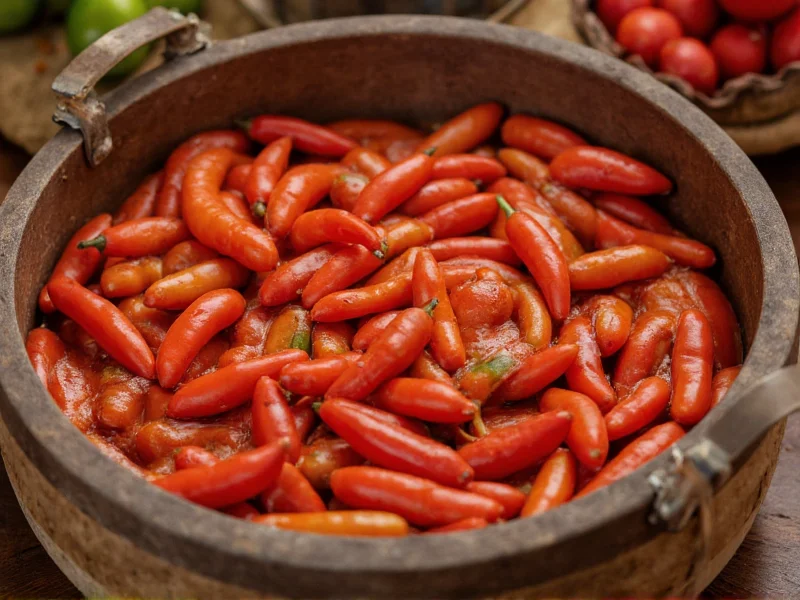Properly stored fresh chili peppers can maintain optimal flavor and heat for 1-3 weeks in the refrigerator, 6-12 months when frozen, and up to 1 year when dried. The best storage method depends on your intended usage timeframe and chili variety, with humidity control and proper air circulation being critical factors for preserving quality.
Chili peppers are culinary treasures that add vibrant flavor and heat to countless dishes, but their perishable nature requires proper storage techniques to maintain quality. Whether you've harvested from your garden or purchased a bulk batch at the market, understanding the science behind chili preservation prevents waste and ensures you always have fresh peppers ready for cooking. This comprehensive guide details evidence-based storage methods that preserve both flavor compounds and capsaicin levels - the compounds responsible for chili heat.
Understanding Different Chili Varieties and Their Storage Needs
Not all chilies share the same storage requirements. Thin-skinned varieties like jalapeños and serranos have higher water content and spoil faster than thick-skinned habaneros or bell peppers. Freshness indicators include firm texture, vibrant color, and absence of wrinkles. When selecting chilies for storage, choose specimens without blemishes, soft spots, or signs of mold, as these will deteriorate rapidly regardless of storage method.
Refrigeration: Optimal Short-Term Storage
Refrigeration remains the most accessible method for preserving fresh chilies. For best results, follow these evidence-based techniques:
- Whole peppers: Store unwashed in the crisper drawer inside a perforated plastic bag with a paper towel to absorb excess moisture
- Temperature control: Maintain 40°F (4°C) or below with 90-95% humidity
- Preparation: Never wash chilies before refrigeration as moisture accelerates decay
- Separation: Keep away from ethylene-producing fruits like apples and bananas
| Chili Type | Refrigerator Duration | Quality Preservation |
|---|---|---|
| Jalapeños, Serranos | 1-2 weeks | Excellent flavor retention for first week |
| Habaneros, Scotch Bonnets | 2-3 weeks | Minimal heat loss for 2 weeks |
| Bell Peppers | 1-2 weeks | Color fades after 10 days |
| Thai Chilies | 7-10 days | Heat intensity decreases after day 5 |
Freezing: Preserving Flavor for Medium to Long-Term Storage
Freezing represents the most effective method for maintaining both flavor and heat in chilies beyond the short term. Research shows properly frozen chilies retain 90% of their capsaicin content for up to 12 months. Two scientifically validated freezing methods exist:
Whole pepper freezing: Wash, dry thoroughly, and place whole peppers in airtight freezer bags with minimal air. This method works best for thicker-skinned varieties. When needed, simply remove the required amount and allow to thaw at room temperature for 15-20 minutes before use.
Flash freezing technique: For individual portions, wash and dry peppers, then arrange on a parchment-lined baking sheet. Freeze for 2 hours until solid, then transfer to freezer bags. This prevents peppers from sticking together, allowing you to remove only what you need. This method preserves cellular structure better than direct bag storage.
Drying: Traditional Long-Term Preservation
Drying concentrates both flavor and heat while dramatically extending shelf life. Three effective drying methods exist:
- Air drying: String peppers through stems and hang in a warm, dry, well-ventilated area away from direct sunlight. Complete drying takes 2-3 weeks depending on humidity.
- Oven drying: Set oven to lowest temperature (140-170°F), place peppers on wire racks, and dry for 6-12 hours with door slightly ajar for moisture escape.
- Dehydrator method: Most consistent results come from using a food dehydrator at 135°F for 8-12 hours until peppers become brittle.
Properly dried chilies should be stored in airtight containers away from light. Rehydration occurs by soaking in hot water for 15-20 minutes before use. Dried chilies maintain peak quality for 6-12 months when stored correctly.
Advanced Preservation Techniques
For culinary enthusiasts seeking maximum versatility, consider these specialized preservation methods:
Oil preservation: Submerging clean, dry chilies in high-quality olive oil creates flavorful infusions while preserving peppers for 3-4 months in the refrigerator. Always ensure peppers remain completely submerged to prevent botulism risk.
Vinegar pickling: Create a brine of equal parts vinegar and water with 1 tablespoon salt per cup. Simmer chilies briefly, then pack in sterilized jars with brine. Properly sealed pickled chilies last 6-12 months refrigerated.
Chili paste freezing: Blend roasted chilies with minimal oil to create a paste, then freeze in ice cube trays. Once solid, transfer cubes to freezer bags for portion-controlled usage in sauces and stews.
Identifying Spoilage and Safety Considerations
Recognizing when chilies have spoiled prevents foodborne illness. Discard peppers showing any of these signs:
- Visible mold in any color (white, green, or black)
- Excessive softness or mushiness beyond normal ripening
- Foul or sour odor
- Significant discoloration (brown or black spots spreading)
- Unpleasant slimy texture
When handling extremely hot varieties like ghost peppers or Carolina reapers, always wear gloves to prevent skin irritation. Never store chilies near open wounds or touch your face during preparation.
Common Storage Mistakes to Avoid
Even with good intentions, many home cooks make critical errors that shorten chili shelf life:
- Storing unwashed chilies in sealed plastic bags without moisture absorption
- Keeping chilies at room temperature for extended periods
- Freezing peppers without proper air removal from storage bags
- Storing whole peppers alongside cut pieces (accelerates decay)
- Using containers that aren't completely airtight for dried chilies
By understanding the biological processes behind chili deterioration - primarily moisture loss, enzymatic browning, and microbial growth - you can implement storage solutions that directly counter these mechanisms.











 浙公网安备
33010002000092号
浙公网安备
33010002000092号 浙B2-20120091-4
浙B2-20120091-4